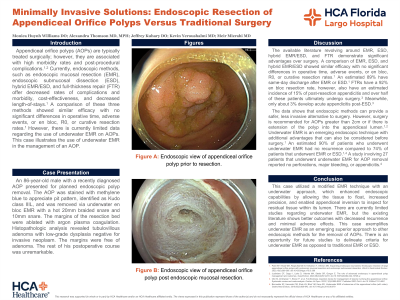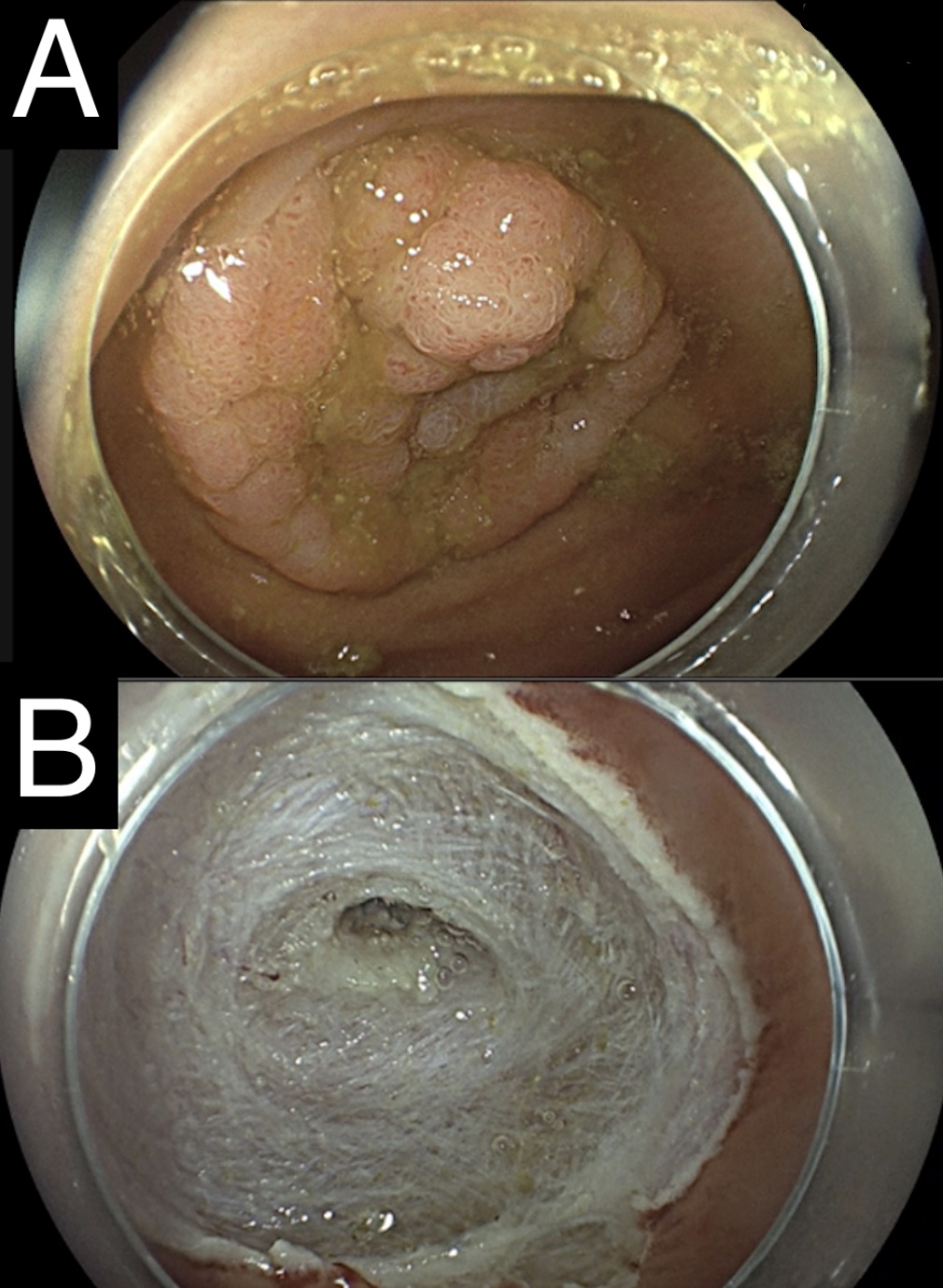Monday Poster Session
Category: Colon
P2092 - Minimally Invasive Solutions: Endoscopic Resection of Appendiceal Orifice Polyps Versus Traditional Surgery
Monday, October 28, 2024
10:30 AM - 4:00 PM ET
Location: Exhibit Hall E

Has Audio

Monica A. Huynh, DO
HCA Florida Largo Hospital
Largo, FL
Presenting Author(s)
Award: Presidential Poster Award
Monica A. Huynh Williams, DO1, Alexandra Thomson, MD, MPH2, Jeffrey Kuhary, DO1, Kevin Yeroushalmi, MD1, Meir Mizrahi, MD1
1HCA Florida Largo Hospital, Largo, FL; 2Memorial Healthcare System, Savannah, GA
Introduction: Appendiceal orifice polyps (AOPs) are typically treated surgically; however, they are associated with high morbidity rates and post-procedural complications.1 Currently, endoscopic methods, such as endoscopic mucosal resection (EMR), endoscopic submucosal dissection (ESD), and hybrid EMR/ESD offer decreased rates of complications and morbidity, cost-effectiveness, and decreased length-of-stays.1 A comparison of these three methods showed similar efficacy with no significant differences in operative time, adverse events, or en bloc, R0, or curative resection rates.1 However, there is currently limited data regarding the use of underwater EMR (UEMR) on AOPs. This case illustrates the use of UEMR in the management of an AOP.
Case Description/Methods: An 86-year-old male with a recently diagnosed AOP presented for planned endoscopic AOP removal. The AOP was stained with methylene blue, identified as Kudo class IIIL, and was removed via en bloc UEMR with a hot snare. Margins of the resection bed were ablated with argon plasma. Histopathologic analysis revealed tubular adenoma negative for high-grade dysplasia. The rest of his postoperative course was unremarkable.
Discussion: While EMR and ESD are well-established alternatives with better outcomes than surgical intervention, UEMR is an emerging technique that presents additional advantages.1 This case utilized a modified EMR technique with an underwater approach, which enhanced endoscopic capabilities by allowing the tissue to float, increased precision, and enabled appendiceal inversion to inspect for residual tissue within its lumen. An estimated 90% of patients who underwent UEMR had no recurrence compared to the 74% of patients that underwent EMR or ESD.1,2 A study involving 27 patients that underwent UEMR for AOP removal reported no perforations, major bleeding, or appendicitis.2 This case exemplifies UEMR as an emerging superior approach to other endoscopic methods for the removal of AOPs.
References

Disclosures:
Monica A. Huynh Williams, DO1, Alexandra Thomson, MD, MPH2, Jeffrey Kuhary, DO1, Kevin Yeroushalmi, MD1, Meir Mizrahi, MD1. P2092 - Minimally Invasive Solutions: Endoscopic Resection of Appendiceal Orifice Polyps Versus Traditional Surgery, ACG 2024 Annual Scientific Meeting Abstracts. Philadelphia, PA: American College of Gastroenterology.
Monica A. Huynh Williams, DO1, Alexandra Thomson, MD, MPH2, Jeffrey Kuhary, DO1, Kevin Yeroushalmi, MD1, Meir Mizrahi, MD1
1HCA Florida Largo Hospital, Largo, FL; 2Memorial Healthcare System, Savannah, GA
Introduction: Appendiceal orifice polyps (AOPs) are typically treated surgically; however, they are associated with high morbidity rates and post-procedural complications.1 Currently, endoscopic methods, such as endoscopic mucosal resection (EMR), endoscopic submucosal dissection (ESD), and hybrid EMR/ESD offer decreased rates of complications and morbidity, cost-effectiveness, and decreased length-of-stays.1 A comparison of these three methods showed similar efficacy with no significant differences in operative time, adverse events, or en bloc, R0, or curative resection rates.1 However, there is currently limited data regarding the use of underwater EMR (UEMR) on AOPs. This case illustrates the use of UEMR in the management of an AOP.
Case Description/Methods: An 86-year-old male with a recently diagnosed AOP presented for planned endoscopic AOP removal. The AOP was stained with methylene blue, identified as Kudo class IIIL, and was removed via en bloc UEMR with a hot snare. Margins of the resection bed were ablated with argon plasma. Histopathologic analysis revealed tubular adenoma negative for high-grade dysplasia. The rest of his postoperative course was unremarkable.
Discussion: While EMR and ESD are well-established alternatives with better outcomes than surgical intervention, UEMR is an emerging technique that presents additional advantages.1 This case utilized a modified EMR technique with an underwater approach, which enhanced endoscopic capabilities by allowing the tissue to float, increased precision, and enabled appendiceal inversion to inspect for residual tissue within its lumen. An estimated 90% of patients who underwent UEMR had no recurrence compared to the 74% of patients that underwent EMR or ESD.1,2 A study involving 27 patients that underwent UEMR for AOP removal reported no perforations, major bleeding, or appendicitis.2 This case exemplifies UEMR as an emerging superior approach to other endoscopic methods for the removal of AOPs.
References
Patel AP, Khalaf MA, Riojas-Barrett M, Keihanian T, Othman MO. Expanding endoscopic boundaries: Endoscopic resection of large appendiceal orifice polyps with endoscopic mucosal resection and endoscopic submucosal dissection. World J Gastrointest Endosc. 2023;15(5):386-396. doi:10.4253/wjge.v15.i5.386
Binmoeller KF, Hamerski CM, Shah JN, Bhat YM, Kane SD. Underwater EMR of adenomas of the appendiceal orifice (with video). Gastrointest Endosc. 2016;83(3):638-642. doi:10.1016/j.gie.2015.08.079

Figure: Figure A: Endoscopic view of appendiceal orifice polyp prior to resection.
Figure B: Endoscopic view of appendiceal orifice polyp post endoscopic mucosal resection.
Figure B: Endoscopic view of appendiceal orifice polyp post endoscopic mucosal resection.
Disclosures:
Monica Huynh Williams indicated no relevant financial relationships.
Alexandra Thomson indicated no relevant financial relationships.
Jeffrey Kuhary indicated no relevant financial relationships.
Kevin Yeroushalmi indicated no relevant financial relationships.
Meir Mizrahi indicated no relevant financial relationships.
Monica A. Huynh Williams, DO1, Alexandra Thomson, MD, MPH2, Jeffrey Kuhary, DO1, Kevin Yeroushalmi, MD1, Meir Mizrahi, MD1. P2092 - Minimally Invasive Solutions: Endoscopic Resection of Appendiceal Orifice Polyps Versus Traditional Surgery, ACG 2024 Annual Scientific Meeting Abstracts. Philadelphia, PA: American College of Gastroenterology.

